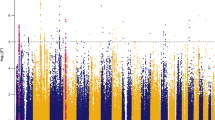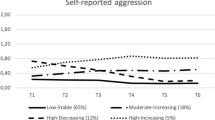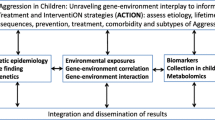Abstract
Aggression in humans is associated with substantial morbidity and mortality. In this study we report on the aggressive behavior syndrome (AGG) in young children as defined by the Child Behavior Checklist (CBCL) and the Teacher Report Form (TRF). We assessed aggression in a large sample of Dutch twins at ages 3, 7, and 10 years. The purpose of this study was three-fold. First, we determined the number of children who are “clinically deviant” on the AGG scale. Second, we assessed the genetic and environmental contributions to AGG for the maternal, paternal, and teacher ratings at each age, for boys and girls. Third, we explored issues of rater bias by analyzing parental and teacher data simultaneously. CBCL data were available from mothers on 6436 three-year-old, 5451 seven-year-old, and 2972 ten-year-old twin pairs and CBCL data from fathers on 4207 three-year-old, 4269 seven-year-old, and 2295 ten-year-old twin pairs. Teacher report data from the TRF were collected for 1036 seven-year-old and 903 ten-year-old twin pairs from the Netherlands Twin Registry. Structural equation modeling was employed to obtain genetic and environmental estimates at each age. Analyses were conducted separately by age and informant, as well as simultaneously, for all informants. Differences in raw scores across gender were found, with boys being rated as more aggressive than girls by all informants. Mothers reported more symptoms than fathers, who reported more symptoms than teachers. Evidence for moderate to high genetic influence (51%–72%) was seen for AGG by all three informants at all ages with only small sex differences in heritability estimates. Best fitting models for AGG by parent reports also included a small contribution of common environment. The largest sex differences in heritabilities were seen at age 10. Contributions of common (13%–27%) and unique (16%–31%) environment were small to moderate. There was some evidence of genetic dominance by teacher report for 10-year-old girls.
Similar content being viewed by others
References
Achenbach, T. M. (1991a). Integrative guide for the 1991 CBCL/4-18, YSR, and TRF profiles. Department of Psychiatry, Burlington, VT: University of Vermont.
Achenbach, T. M. (1991b). Manual for the Child Behavior Checklist/4-18. University of Vermont, Burlington, VT: Department of Psychiatry.
Achenbach, T. M. (1991c). Manual for the Teacher's Report Form and 1991 Profile. University of Vermont, Burlington, VT: Department of Psychiatry.
Achenbach, T. M. (1992). Manual for the Child Behavior Checklist/2-3 and 1992 Profile. Burlington, VT: University of Vermont, Department of Psychiatry.
Achenbach, T. M., and Rescorla, L. A. (2000). Manual for the ASEBA Preschool Forms & Profiles. Burlington, VT: University of Vermont, Research Center for Children Youth, & Families.
Achenbach, T. M., and Rescorla, L. A. (2001). Manual for the ASEBA School-Age Forms & Profiles. Burlington, VT: University of Vermont, Research Center for Children Youth, & Families.
Akaike, H. (1987). Factor analysis and AIC. Psychometrika 52:317-322.
Bartels, M., Boomsma, D. I., Rietveld, M. J. H., van Beijsterveldt, C. E. M., Hudziak, J. J., and van den Oord, E. J. C. G. (2003a). Disentangling genetic, environmental, and rater effects on internalizing and externalizing problem behavior in 10-year-old twins. J. Child Psychology and Psychiatry (under revision).
Bartels, M., Hudziak, J. J., Boomsma, D. I., Rietveld, M. J. H., van Beijsterveldt, C. E. M., and van den Oord, E. J. C. G. (2003b). A study of parent ratings of internalizing and externalizing problem behavior in 12-year-old twins. J. Am. Acad. Child. Adolesc. Psychiatry (in press).
Bartels, M., Hudziak, J. J., van den Oord, E. J. C. G., van Beijsterveldt, C. E. M., Rietveld, M. J. H., and Boomsma, D. I. (2003). Co-occurrence of aggressive behavior and rule-breaking behavior at age 12: Multirater analyses. Behavior Genetics 33:607-622.
Bergeman, C. S., and Seroczynski, A. D. (1998). Genetic and environmental influences on aggression and impulsivity. In M. Maes, and E. F. Coccaro (Eds.), Neurobiology and clinical views on aggression and impulsivity (Vol. 5); (pp. 63-80). Chichester: John Wiley and Sons.
Biederman, J., Faraone, S. V., Doyle, A., Lehman-Krifcher, B., Kraus, I., Perrin, J., and Tsuang, M. T. (1993). Convergence of the Child Behavior Checklist with structured interview-based psychiatric diagnoses of ADHD children with and without comorbidity. J. Child Psychol. Psychiatry 34:1241-1251.
Boomsma, D. I. (1998). Twin registers in Europe: An overview. Twin Res. 1:34-51.
Boomsma, D. I., Vink, J. M., van Beijsterveldt, C. E. M., de Geus, E. J. C., Beem, A. L., Mulder, E. J. C. M., Riese, H., Willemsen, A. H. M., Bartels, M., van den Berg, M., Derks, E. M., de Graaff, S. C., Kupper, H. M., Polderman, J. C., Posthuma, D. I., Rietveld, M. J. H., Stubbe, J. H., Knol, L. I., Stroet, T., and van Baal, G. C. M. (2002). Netherlands Twin Register. Twin Res. 5:401-406.
Brunner, H. G., Nelen, M., Breakfield, X. O., Ropers, H. H., and Oost, B. A. (1993). Abnormal behavior associated with a point mutation in the structural gene for monoamine oxidase A. Science 262:578-580.
Burke, J. D., Loeber, R., and Birmaher, B. (2000). Oppositional defiant disorder and conduct disorder: A review of the past 10 years: II. J. Am. Acad. Child Adolesc. Psychiatry 39:1275-1293.
Campbell, M., and Cueva, J. E. (1995). Psychopharmacology in child and adolescent psychiatry: A review of the past seven years: II. J. Am. Acad. Child Adolesc. Psychiatry 34:1262-1272.
Carey, G. (1986). Sibling imitation and contrast effects. Behav. Genet. 16:319-341.
Caspi, A., McClay, J., Moffitt, T. E., Mill, J., Martin, J., Craig, I. W., Taylor, A., and Poulton, R. (2002). Role of genotype in the cycle of violence in maltreated children. Science 297:851-854.
CBS. (1993). Standaard Beroepenclassificatie 1992 [standardized classifications of occupations 1992]. Voorburg/Heerlen, The Netherlands: Central Bureau of Statistics.
Chen, W. J., Faraone, S. V., Biederman, J., and Tsuang, M. T. (1994). Diagnostic accuracy of the Child Behavior Checklist scales for attention deficit-hyperactivity disorder: A receiver-operating characteristic analysis. J. Consult. Clin. Psychol. 62:1017-1025.
Deater-Deckard, K., and Plomin, R. (1999). An adoption study of the etiology of teacher and parent reports of externalizing behavior problems in middle childhood. Child Dev. 70:144-154.
Eaves, L. J. (1976). A model for sibling effects in man. Heredity 36:205-214.
Eaves, L. J. (1982). The utility of twins. In V. E. Anderson, W. A. Hauser, J. K. Penry, and C. F. Sing (Eds.), Genetic basis of the epilepsies (pp. 249-276). New York: Raven Press.
Edelbrock, C., Rende, R., Plomin, R., and Thomson, L. A. (1995). A twin study of competence and problem behavior in childhood and early adolescence. J. Child Psychol. Psychiatry 36:775-785.
Ghodsian-Carpey, M., and Baker, L. A. (1987). Genetic and environmental influences on aggression in 4-to 7-year old twins. Aggress. Behav. 13:173-186.
Goldsmith, H. H. (1991). A zygosity questionnaire for young twins: A research note. Behav. Genet. 21:257-270.
Hartung, C. M., and Widiger, T. A. (1998). Gender differences in the diagnosis of mental disorders: Conclusions and controversies of the DSM-IV. Psychol. Bull. 123:260-278.
Hewitt, J. K., Silberg, M. C., Neale, M. C., Eaves, L. J., and Erickson, M. (1992). The analysis of parental ratings of children's behavior using LISREL. Behav. Genet. 22:293-317.
Hudziak, J. J., Copeland, W., Stanger, C., and Wadsworth, M. (2003). Diagnosing externalizing behavior problems with the child behavior checklist: A quality receiver-operating curve analysis. J. Child Psychology and Psychiatry and Allied Disciplines (in press).
Hudziak, J. J., Rudiger, L., Neale, M., Heath, A., and Todd, R. A. (2000). A twin study of inattentive, aggressive, and anxious/depressed behavior. J. Am. Acad. Child Adolesc. Psychiatry 39:469-476.
Koot, H. M., van den Oord, E. J. C. G., Verhulst, F. C., and Boomsma, D. I. (1997). Behavioral and emotional problems in young preschoolers: Cross-cultural testing of the validity of the Child Behavior Checklist/2-3. J. Abnorm. Child Psychol. 25:183-196.
Last, C. G. (1989). Anxiety disorders. In T. H. Ollendick and M. Hersen (Eds.), Handbook of child psychopathology (pp. 219-228). New York: Plenum Press.
Lewis, M., and Miller, S. M. (1990). Handbook of developmental psychopathology. New York: Plenum Press.
Loeber, R., Burke, J., Lahey, B., Winters, A., and Zera, M. (2000). Oppositional defiant and conduct disorder: A review of the past 10 years: I. J. Am. Acad. Child Adolesc. Psychiatry 39:1468-1484.
Miles, D. R., and Carey, G. (1997). Genetic and environmental architecture of human aggression. J. Pers. Social Psychol. 72:207-217.
Moffitt, T. E. (1993). Adolescence-limited and life-course-persistent antisocial behavior: A developmental taxonomy. Psychol. Rev. 100:674-701.
Neale, M. C., and Stevenson, J. (1989). Rater bias in the EASI Temperament scales: A twin study. J. Pers. Soc. Psychol. 56:446-455.
Neale, M. C., and Cardon, L. R. (1992). Methodology for genetic studies of twins and families. Dordrecht: Kluwer Academic.
Neale, M. C., Boker, S. M., Xie, G., and Maes, H. H. (1999). Mx: Statistical Modeling (5th ed.). VCU Box 900126, Richmond, VA 23298: Dept. of Psychiatry (5th ed.).
Plomin, R., DeFries, J. C., McClearn, G. E., and Rutter, M. (1997). Behavioral genetics. New York: W. H. Freeman.
Rhee, S. H., and Waldman, I. D. (2002). Genetic and environmental influences on antisocial behavior: A meta-analysis of twin and adoption studies. Psychol. Bull. 128:490-529.
Rietveld, M. J., Hudziak, J. J., Bartels, M., van Beijsterveldt, C. E., Boomsma, D. I. (2003a). Heritability of attention problems in children. I: Cross sectional results from a study of twins, age 3–12 years. Am. J. Med. Genet. 117B:102-112.
Rietveld, M. J. H., Posthuma, D., Dolan, C. V., and Boomsma, D. I. (2003b). ADHD: Sibling interaction or dominance—An evaluation of statistical power. Behav. Genet. 33:247-255.
Rietveld, M. J. H., VanderValk, J. C., Bongers, I. L., Stroet, T. M., Slagboom, P. E., and Boomsma, D. I. (2000). Zygosity diagnosis in young twins by parental report. Twin Res. 3:134-141.
Robins, L., and Rutter, M. (1990). Straight and devious pathways from childhood to adulthood. Cambridge: Cambridge University Press.
Schmidt, L., Fox, N. A., Rubin, K. H., Hu, S., and Hamer, D. H. (2002). Molecular genetics of shyness and aggression in preschoolers. Pers. Indiv. Diff. 33:227-238.
Simonoff, E., Pickles, A., Hervas, A., Silberg, J. L., Rutter, M., and Eaves, L. (1998). Genetic influences on childhood hyperactivity: Contrast effects imply parental rating bias, not sibling interaction. Psychol. Med. 28:825-837.
Stanger, C., Achenbach, T. M., and Verhulst, F. C. (1997). Accelerated longitudinal comparisons of aggressive versus delinquent syndromes. Dev. Psychopath. 9:43-58.
Steingard, R., Biederman, J., Doyle, A., and Sprich-Buckminster, S. (1992). Psychiatric comorbidity in attention deficit disorder: Impact on the interpretation of the Child Behavior Checklist results. J. Am. Acad. Child Adolesc. Psychiatry 31:449-454.
van Beijsterveldt, C. E. M., Bartels, M., Hudziak, J. J., and Boomsma, D. I. (2003). Causes of stability of aggression from early childhood to adolescence: A longitudinal genetic analysis in dutch twins. Behavior Genetics 33:591-606.
van den Oord, E. J. C. G., Verhulst, F. C., and Boomsma, D. I. (1996). A genetic study of maternal and paternal ratings of problem behaviors in three-year-old twins. J. Abnorm. Psychol. 105:349-356.
van der Valk, J. C., Verhulst, F. C., Stroet, T. M., and Boomsma, D. I. (1998). Quantitative genetic analysis of internalizing and externalizing problems in a large sample of 3-year-old twins. Twin Res. 1:25-33.
van der Valk, J. C., van den Oord, E. J., Verhulst, F. C., and Boomsma, D. (2001). Using parental ratings to study the etiology of 3-year-old twins' problem behaviors: Different views or rater bias? J. Child Psychol. Psychol. 42:921-931.
van der Valk, J. C., van den Oord, E. J. C. G., Verhulst, F. C., and Boomsma, D. I. (2003). Using common and unique parental views to study the etiology of 7-year-old twins' internalizing and externalizing problems. Behav. Genet. (in press).
Verhulst, F. C., and Koot, H. M. (1991). Longitudinal research in child and adolescent psychopathology. J. Am. Acad. Child Adolesc. Psychiatry 30:361-368.
Vierikko, E., Pulkkinen, L., Kaprio, J., Viken, R., and Rose, R. J. (2003). Sex differences in genetic and environmental effects on aggression. Aggress. Behav. 29:55-68.
Rights and permissions
About this article
Cite this article
Hudziak, J.J., van Beijsterveldt, C.E.M., Bartels, M. et al. Individual Differences in Aggression: Genetic Analyses by Age, Gender, and Informant in 3-, 7-, and 10-Year-Old Dutch Twins. Behav Genet 33, 575–589 (2003). https://doi.org/10.1023/A:1025782918793
Issue Date:
DOI: https://doi.org/10.1023/A:1025782918793




